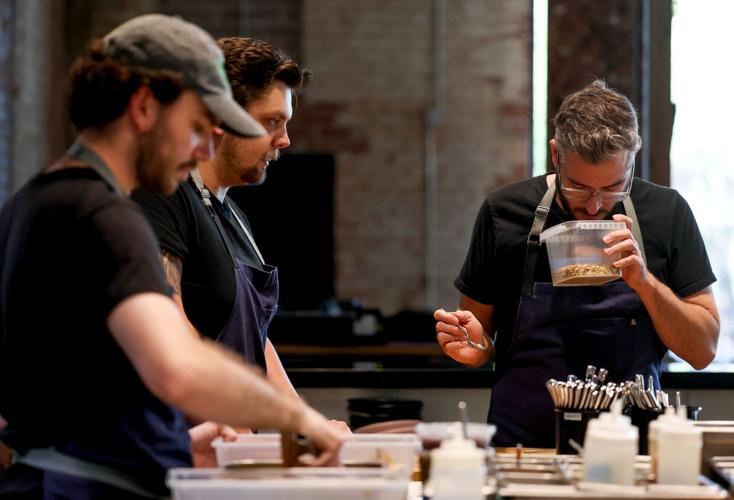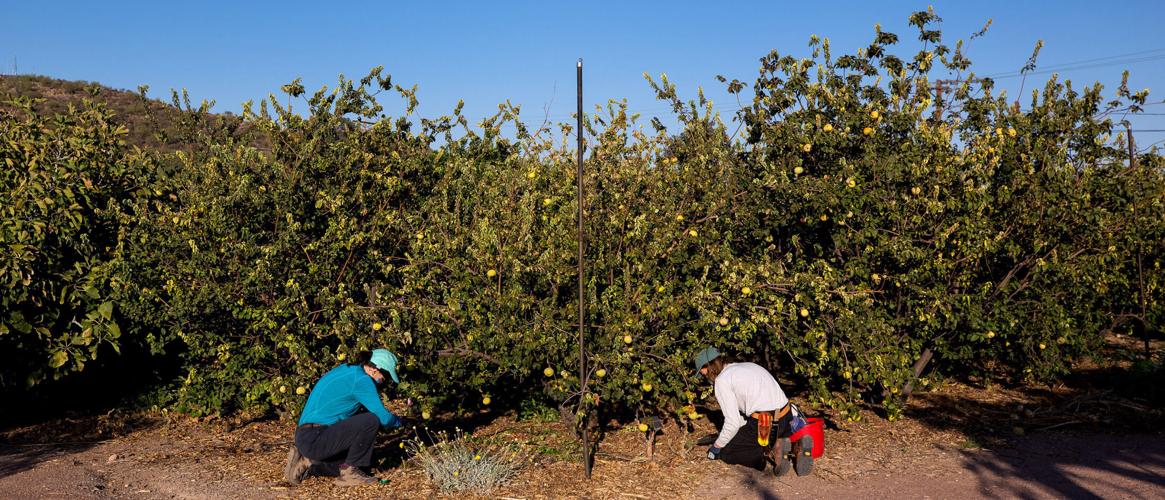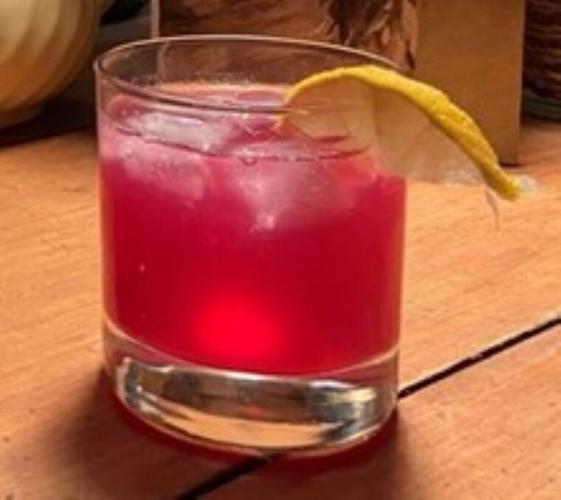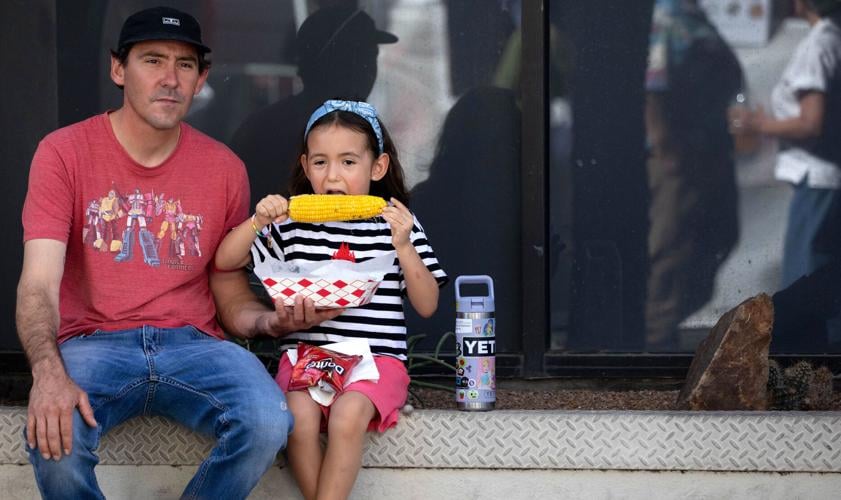In all his years in Tucson’s restaurant scene, Tyler Fenton had never had an out-of-town guest say that Tucson’s cuisine was the reason for their visit.
But two years ago, when he opened his innovative upscale restaurant Bata at 35 E. Toole Ave. in downtown’s historic Warehouse District, a table of Midwest diners said just that.
“They had read that we were a cool food town … and that was the sole reason they came to Tucson,” said the Bata chef-owner, whose family also has Reilly Craft Pizza & Drink at 101 E. Pennington St. downtown. “That was definitely really cool to hear and the frequency we hear that has definitely gone up. That recognition and any press is driving a new demographic to Tucson that we weren’t previously seeing.”
People are also reading…

Tyler Fenton, right, the owner and head chef at Bata, smells different ingredients before they are added to the dinner menu on Aug. 15.
Tucson Food Tours also has seen an uptick in guests focused on exploring the area’s diverse food scene since the Old Pueblo was named the country’s first UNESCO Creative City of Gastronomy in late 2015.
“If it’s not the main reason (for the visit), it definitely becomes a focal point of their stay,” said Bradner Lawrence, who launched the food and culture tours with his wife and partner Maria in 2012. “The word is getting out there. Initially no one had a clue (about the City of Gastronomy). Now people have heard about it.”
Elysa Crum said out-of-town visitors on her Taste of Tucson Downtown culinary tours, which she launched two years after the Lawrences, are more familiar with the designation than local residents taking her tours.
“Maybe we take it for granted because the food’s so good and there’s so much of it,” she reasoned.
Recent economic studies seem to bear out the anecdotes.
The increase in visitor spending in Tucson restaurants illustrates the food scene becoming more of a tourism driver, said Jonathan Mabry, executive director of the Tucson City of Gastronomy.
In the nine years since the city landed the UNESCO designation, visitor spending in Pima County restaurants has grown from $600 million in 2016 to just shy of $800 million in 2022, according to a study Dean Runyan Associates conducted for the Arizona Office of Tourism.

Jonathan Mabry is executive director of Tucson City of Gastronomy.
The food service sector also drove the statewide COVID-19 pandemic recovery in 2021, recouping nearly all of the pandemic visitor sales lost when restaurants were forced to close their dining rooms for several months. Visitors, who only spent $385 million in Pima County restaurants in 2020, spent $727 million in the post-pandemic 2021, which was $5 million off 2019’s $732 million in sales, according to state reporting.
Arizona’s most recent figures from 2022 show continued growth in Pima County’s restaurant sector, with visitors spending $797 million, nearly a third of the total $3 billion visitors spent in the county that year.
“The increase in food tourism since the designation is lifting all boats,” from the high-end downtown restaurants like Bata to the generational Sonoran-style Mexican eateries in South Tucson, Mabry said. “It’s good for the economy.”
Only part of the story
Restaurants tell only a small part of Tucson’s culinary story, one rooted in our farm-to-table ethos and the food heritage passed on from generations of Native American, Mexican and Anglos who have coexisted in the Sonoran Desert connecting the borderlands.
“The Creative Cities designation was not a recipe; it was a validation of what was already happening in Tucson and that gave us the credibility,” said J. Felipe Garcia, Visit Tucson president and CEO. “It allowed us to bring a spotlight to our community. It’s helping us to put the scale to our advantage.”
The UNESCO credibility opened the door for Garcia to start pitching the full story of Tucson’s restaurant scene and food heritage.
It wasn’t a hard sell, really. When Garcia would tell travel writers and other journalists about Tucson’s UNESCO designation, they would become easily intrigued: How did a city in the middle of the desert, far from the foodie hubs of Chicago, New York or Los Angeles, become the first American City of Gastronomy?

Garcia
He’d talk about our unique restaurants including El Charro, the oldest, continuously operated Mexican restaurant in America, birthplace of the deep-fried chimichanga (or so they say). He’d brag about the diversity of restaurants that included Middle Eastern, Asian and European cuisine complementing the plethora of the city’s signature Sonoran-style Mexican restaurants, including the generational restaurants lining South Fourth Avenue in the City of South Tucson.
But the real story is how many of those restaurants are keeping the region’s cultural food heritage alive and relevant.
That heritage goes back as far as 5,500 years, when the Tohono O’odham and those who followed found a way to grow the three sisters — corn, beans and squash — and other foods in the arid borderlands, some of which is on living display at Mission Garden.
Inside the 4-acre living architectural museum near Sentinel Peak, volunteers grow heritage crops (including squash, barley, tepary beans) and heirloom trees (limes, oranges, figs, grapefruit, peaches, quince and pomegranates among them).
Garden produce is donated to food pantries and refugee groups, while volunteers also benefit. Some of it also goes to restaurants and bakeries.
“We’re moving a lot of their quince and figs,” said Pivot Produce founder Erik Stanford, whose company supplies Tucson restaurants with locally grown produce including from Mission Garden.
Mission Garden demonstrates how early Hohokam and O’odham people were able to tame the harsh land to grow food. The O’odham created an expansive irrigation system and harvested rainwater, establishing a template for growing desert-adapted foods that can tolerate the arid conditions, said Tucson ethnobotanist Gary Nabhan.

Volunteers place tubes for irrigation under Quince trees inside the Spanish Colonial Orchard at Mission Garden in Tucson in 2020. Located at the base of Sentinel Peak, Mission Garden, a nonprofit organization, is a living agricultural museum of Sonoran Desert-adapted heritage fruit-trees, traditional local crops and edible native plants. The gardens mission is to preserve, transmit and revive the region’s agricultural heritage by growing gardens which represent more than 4,000 years of continuous cultivation in the Tucson Basin.
That climate-smart playbook is now being put to the test by the Arizona Partnership for Climate-Smart Food Crops fund, a three-year, $4.7 million study spearheaded by the University of Arizona with partners that include Tucson City of Gastronomy, Arizona-Sonora Desert Museum and Local First Arizona.
The goal is to encourage growers to adopt climate-smart practices, from growing desert-adaptable crops and diverse cover crops to reducing the use of fertilizer and pesticides, said Patty Emmert, director of Local First’s Resilient Food Systems, one of the fund’s boots-on-the-ground organizers.
“There are more than 200 edible plants in the Sonoran Desert that the Tohono O’odham has traditionally gathered over thousands of years” that are part of today’s Tucson food culture, said Mabry. “Not only do we have that foundation of those indigenous foods, we also have more than a 300-year-old tradition of orchards and vineyards and wheat and cattle ranching, all of which were introduced during the Spanish colonial period.”
Heritage on the plate
Tucson’s first-ever James Beard Award-winning chef Janos Wilder sees it as his mission to make ingredients such as nopalitos, heritage squash grown on the Tohono O’odham Nation and the nation’s yellow watermelon so popular that chefs will clamor for them.
“My role is to popularize those ingredients so that there is demand for them,” he said, which, in hindsight, might be what he subconsciously has been doing throughout his 40-year cooking career.

Wilder
When he opened his flagship Janos restaurant at the historic Stephens House in 1983, he hired gardeners before he started looking for servers, with the goal of sourcing ingredients with “local and hyper-local foods,” becoming one of the pioneers of Tucson’s farm-to-table movement. From the start, he set out to create a menu largely dependent on what he could find from local growers and what he could grow in his own garden.
“I really wanted to inform my cooking with really great ingredients,” he said.
When he discovered Native Seeds/SEARCH, which Nabhan and three associates founded in 1983, “that really turned the corner for me,” Wilder said. Native Seeds/SEARCH conserves and shares seeds from the region’s arid-adapted crops.
“For me, that was taking the hyper-local and taking back the historic, as well,” he said. ”You really start from that point.”
Soon nopalitos were featured on his menu, sometimes sauteéd or stewed, occasionally pickled. When he could get it, he drizzled saguaro syrup made from concentrating cactus flowers onto dishes, adding a rich, dark flavor profile reminiscent of molasses. The versatile prickly pear became a sweet and savory component as well as a refreshing kick to cocktails and aguas frescas.
“I look to the past for a vision to the future, which is how do I take these ancient ingredients and, with modern techniques and modern sensibility, what does the future look like, not only in a culinary sense but from a sustainability and climate change aspect, as well,” said Wilder, who continues working with heritage and locally sourced foods at his post-retirement venture Studio Janos.
That farm-to-table ethos spread but the use of heritage foods was a harder sell for some Tucson restaurants until folks like Tucson baker Don Guerra reintroduced them.
From the early loaves he baked in his Tucson garage, Guerra has employed Sonoran White Wheat as the central ingredient for his James Beard Award-winning Barrio Bread, invigorating a conversation about those heritage grains still being cultivated in the Sonoran Desert region.
Wendy Garcia made prickly pear fruit and nopales, cholla buds and mesquite pods central ingredients at her James Beard-nominated vegan Mexican restaurant Tumerico at 2526 E. Sixth St. that she opened in 2014.
Wilder’s protegé Devon Sanner and his business partner Mat Cable wanted diners to taste Tucson in every bite at their three-year-old Italian-fusion restaurant Zio Peppe at 6502 E. Tanque Verde Road. Mesquite flour is the basis of the pizza dough and toppings include prickly pear, nopales and cholla buds pickled in pepperoncini brine.

At Italian-fusion restaurant, mesquite flour is the basis of the pizza dough and toppings include prickly pear, nopales and cholla buds pickled in pepperoncini brine.
Even Wilder, who closed his last restaurant Downtown Kitchen + Cocktails in October 2020, is still innovating with heritage ingredients at his year-old culinary venture Studio Janos, where he hosts private dinners including one that takes a deep dive into modern executions with heritage ingredients.
“You go to most of the United States and they go, ‘Well, (Native Americans) farmed here,’ but they don’t have the co-op where people are still farming today,” said Nabhan, one of the architects of Tucson’s initial City of Gastronomy application in 2014.
Nabhan is a pioneer in the national slow food movement and an ardent fan of Tucson’s food scene, from its nearly 1,000 restaurants and roughly 700 food trucks to its 10 weekly farmers markets that attract 430,000 visitors a year, according to the Tucson City of Gastronomy.
Nabhan said he was inspired to pursue the designation by the Tucson restaurants and food purveyors he felt were thinking way outside the box of their counterparts regionally and nationwide. In that innovative spirit, the James Beard Award-winning author saw a little bit of magic.
“We were using things that were completely unique to the American food system,” he said, citing the mission grapes brought to New Mexico and Southern Arizona by Spanish missionaries in the early 1600s that predated anything grown in Napa Valley and the ubiquitous use of mesquite-wood that adds the smoky notes to our celebrated Whiskey Del Bac and several dishes at James Martinez’s James Beard-nominated Tito & Pep at 4122 E. Speedway.
A story with no end in sight
Visit Tucson’s Garcia estimates hundreds of publications around the world have picked up on the story of Tucson’s food scene and its improbable City of Gastronomy designation.
They’ve captured sweeping images of the Catalina Mountains and Saguaro National Park as the backdrop for stories on the legendary downtown Mexican restaurant El Charro, which still roof-dries its carne seca at its flagship eatery at 311 N. Court Ave., and the prickly pear margaritas featured on a number of menus including the north-side El Chinito Gordo at 2920 N. Oracle Road, where guava is thrown in for good measure.
They’ve told stories of Tucson’s signature Sonoran hot dog that earned Daniel Contreras and his El Guero Canelo (5201 S. 12th Ave. and two other Tucson locations) the James Beard Award, and the diversity of downtown restaurants from the casual burger and ice cream joint The Hub, 266 E. Congress St., to Fenton’s critically acclaimed Bata.
Garcia and Mabry figured they had a window of a year or two before Tucson and its City of Gastronomy designation was old news.
They were wrong.
“We never were able to envision and anticipate how huge it has been and will continue to be,” Garcia said, estimating the annual value of the media coverage at $30 million.
“I just think the increased attention nationally and worldwide is substantial,” said Tucson Originals President Terry Kyte, whose family owns Bisbee Breakfast Club (4131 W. Ina Road and five other Tucson-area locations) and Bashful Bandit Barbecue, 3686 E. Speedway. “From myself, noticing media attention and mentions of Tucson that ties to the food scene is huge. I have been amazed.”
Tucson’s restaurants are no strangers to TV cameras, mind you. A few years before the designation, national shows including Food Network’s “Diners, Drive-ins and Dives” with Guy Fieri and Travel Channel’s “Man vs. Food” had featured Tucson restaurants.
Travel Channel’s Adam Richman took on the 12-patty OMG Burger at Lindy’s on North Fourth Avenue for “Man vs. Food” in 2009. Food Network star Bobby Flay came here in 2010 to throw down with Teresa’s Mosaic Cafe on the west side. Guy Fieri featured several restaurants (Rocco’s Little Chicago Pizzeria, Chef Alisah’s Bosnian restaurant, Zemam’s Ethiopian, Renee’s, Tumerico and Inca’s Peruvian Cuisine) when he brought his “Diners, Drive-Ins and Dives” show here in 2018.
Maria Mazon shined a huge spotlight on Tucson and its food scene when she finished in the top five on “Top Chef Portland” in 2021. The Bravo network show attracts as many as 3 million viewers a week, which was incentive enough for Visit Tucson to invest $750,000 to bring “Top Chef Houston” here to film its final two episodes in 2022.
“This is an amazing commercial but more than a commercial, it is a way to tell the culinary story of our community,” Garcia said at the time. “We want to make sure that they are talking about Tucson and sharing that experience. People who will travel for food, I think this is definitely a destination driver.”
Banking on food tourism
Mabry said he would love to find synergy between food festivals and other tourism-driving events in Tucson. He cites as an example the annual Tucson International Mariachi Conference, which brings in an average of 40,000 people every April.
“I want to create a month where visitors know that if they come in any part of that month there’s going to be some exciting food and cultural things happening,” he said. “We can all see that there is already synergy, but we can create more if we work together.”
It wouldn’t be hard, he reasoned; 65 days a year, you can find a major food or drink event in Tucson, from the hugely popular Southern Arizona Salsa, Tequila & Taco Challenge being held at Oro Valley’s El Conquistador Resort, 10000 N. Oracle Road, on Aug. 24 to the Agave Heritage Festival that takes up four days in April, exploring the science, cultural history and environmental attributes of the central ingredient of tequila.

Edgar Lanay, left, holds a tray for his daughter Luna Lanay while she enjoys corn on the cob at Tucson Meet Yourself.
The folklife festival Tucson Meet Yourself in October boasts the biggest crowds, with 120,000 showing up at Jácome Plaza downtown over the three days. And one of Tucson’s newest foodie fests is the international Pueblos del Maiz that in April brought in 5,500 people over three days to explore the region’s culinary and cultural ties to corn.
Pueblos del Maiz is the Tucson City of Gastronomy’s biggest public-facing event of the year, pumping a million dollars into the economy, Mabry noted. The festival was created three years ago by Mabry and his City of Gastronomy counterparts in Merida, Mexico, and San Antonio, Texas, the only other American city with the designation. Bergamo, Italy, joined this year’s festival, which is held over three days in each of the host cities starting with Tucson. Merida held its event in May and Bergamo and San Antonio are doing theirs in September and October, respectively.
“We hope to see that continue to grow,” Mabry said.
One way to do that, he said, would be to team up with the Agave Heritage Fest organizers and market the two events together with the Tucson International Mariachi Conference held around the same time.
Something crazy good is happening here
Out-of-town restaurants and hotel operators who didn’t pay Tucson a second of attention 12, 15 years ago, are now clamoring to cash in on our food-driven popularity, said Fletcher McCusker, Rio Nuevo board chairman.
“We are definitely on the radar of companies that wouldn’t have had us on their radar without that designation,” said McCusker, whose agency is responsible for downtown redevelopment that extends to the Sunshine Mile on East Broadway, all the way to Park Place mall.
McCusker name-drops a couple of ventures attracted to Tucson because of the restaurant scene including Arizona’s only franchise of the French pastry shop Le Macaron at 260 E. Congress St., which opened last November, and an inquiry earlier this year by Eugene, Oregon-based boutique hotel operator Obie Companies, which is looking at the possibility of building a hotel and festival alley with bars, restaurants and shops on a vacant lot at 75 E. Broadway. Last December, Starbucks announced it was opening a mobile-app-driven pickup only location in the old Chicago Store at 130 E. Congress St.
“We’ve always believed that food and music was what was going to drive Tucson’s economy,” McCusker said. “You can see that over the years. Ultimately that has attracted hoteliers and restaurants.”
But the restaurant development is not limited to downtown, McCusker is quick to note.
Rio Nuevo has invested in several projects along the Sunshine Mile, extending from South Country Club Road to North Euclid Avenue on Broadway, including pumping $900,000 into Z Street. The Afrocentric village, which stretches from the corner of Broadway and Treat Avenue to the parking lot at Rocco’s Little Chicago at 2711 E. Broadway, is anchored by the longtime Ethiopian restaurant Zemam’s at 2731 E. Broadway and includes an international bar and coffee house.
The Tucson Gastronomy Collective being created at seven historic bungalows along East Broadway in the Sunshine Mile district could prove to be one of Tucson City of Gastronomy’s biggest calling cards.
The project by developers Randi Dorman and Peter Anadranistakis will serve as a foodie hub that will include a demonstration kitchen, a restaurant, a bagel and pizza shop, a marketplace and a cafe.
“The purpose is to shine a spotlight on why we are a UNESCO City of Gastronomy,” Dorman said. “Each bungalow is going to house a different food offering that is representative of an aspect of what made us a City of Gastronomy to begin with.”
Dorman said she has gotten letters of intent from tenants including Barrio Bread’s Guerra, bringing Barrio Bagel & Slice, a pizza and bagel concept; Tucson Foodie, which will operate the marketplace; and Athena Aden, opening the Mexican-fusion Sonoran Sunrise Cafe.
The collective also will include a demonstration and commercial kitchen, which will host local and international chefs and be available to the tenants.
Dorman said the project should be open by the end of 2025.
“Each of these things,” McCusker said of Tucson’s evolving restaurant scene, “kind of builds this destination that you see in Austin and you see in Pasadena and you see in Dallas.”
Visit Tucson’s Garcia won’t go quite as far as to say Tucson is a food destination, although, he allowed, “we’re getting here.”
“We’re not 100%, but we are starting to see that momentum happening,” he said. “We are getting that attention from the visitors coming to our community.”

Janos Wilder’s cocktail recipe features Whiskey del Bac and prickly pear syrup.
Contact reporter Cathalena E. Burch at cburch@tucson.com. On Twitter @Starburch























